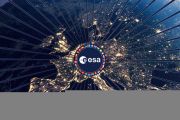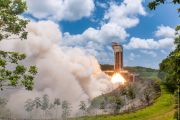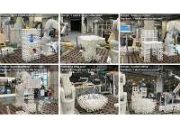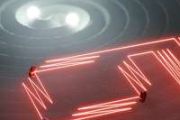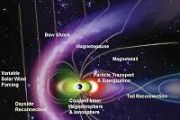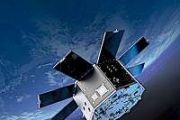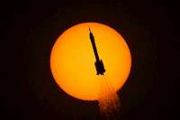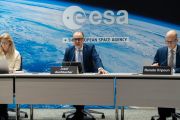
Copernical Team
Army award-winning research to transform Soldier-robot communication
 Army researchers developed ground-breaking technology that will enhance how Soldiers and robots communicate and carry out tasks in tactical environments.
This research sets out to develop a natural language understanding, or NLU, pipeline for robots that would be easily ported over to any computational system or agent and incrementally tames the variation that we see in natural language, s
Army researchers developed ground-breaking technology that will enhance how Soldiers and robots communicate and carry out tasks in tactical environments.
This research sets out to develop a natural language understanding, or NLU, pipeline for robots that would be easily ported over to any computational system or agent and incrementally tames the variation that we see in natural language, s Gearing up for third Sentinel-2 satellite

With the first Copernicus Sentinel-2 satellite in orbit since 2015 and the second since 2017, engineers are busy preparing the mission’s follow-on pair to eventually pick up the baton to supply images for a myriad of applications from food security to monitoring the decline of Earth’s ice. Slated for launch at the beginning of 2024, Sentinel-2C has just started a punishing five-month testing programme to ensure that it is fit for its life in space.
New ESO observations show rocky exoplanet has just half the mass of Venus
 A team of astronomers have used the European Southern Observatory's Very Large Telescope (ESO's VLT) in Chile to shed new light on planets around a nearby star, L 98-59, that resemble those in the inner Solar System. Amongst the findings are a planet with half the mass of Venus - the lightest exoplanet ever to be measured using the radial velocity technique - an ocean world, and a possible plane
A team of astronomers have used the European Southern Observatory's Very Large Telescope (ESO's VLT) in Chile to shed new light on planets around a nearby star, L 98-59, that resemble those in the inner Solar System. Amongst the findings are a planet with half the mass of Venus - the lightest exoplanet ever to be measured using the radial velocity technique - an ocean world, and a possible plane Scientists Have New Data on the Nearest Planet to the Sun
 An international team of planetary scientists from Russia, Finland, and the United States has analyzed for the first time the factors that determine the number of boulders on the surface of the nearest planet to the Sun, Mercury. Boulders are fragments of rock that form as a result of meteorite impacts on the planet's surface and are located in areas of fresh impact craters hundreds of meters in
An international team of planetary scientists from Russia, Finland, and the United States has analyzed for the first time the factors that determine the number of boulders on the surface of the nearest planet to the Sun, Mercury. Boulders are fragments of rock that form as a result of meteorite impacts on the planet's surface and are located in areas of fresh impact craters hundreds of meters in Astronomers find evidence of possible life-sustaining planet
 Astronomers have found signs of a planet that may have a life-supporting atmosphere, according to a study published Thursday.
The study, published in Astronomy & Astrophysics, focuses on a planetary system named after the star it orbits, L 98-59, according to a press release. Using the European Southern Observatory's Very Large Telescope in Chile, the team of astronomers found a roc
Astronomers have found signs of a planet that may have a life-supporting atmosphere, according to a study published Thursday.
The study, published in Astronomy & Astrophysics, focuses on a planetary system named after the star it orbits, L 98-59, according to a press release. Using the European Southern Observatory's Very Large Telescope in Chile, the team of astronomers found a roc NASA begins recruitment for long-duration Mars Mission Analog Study
 As NASA ventures farther into the cosmos, the astronaut experience will change. In preparation for the real-life challenges of future missions to Mars, NASA will study how highly motivated individuals respond under the rigor of a long-duration, ground-based simulation.
NASA is now accepting applications for participation as a crew member during the first one-year analog mission in a habita
As NASA ventures farther into the cosmos, the astronaut experience will change. In preparation for the real-life challenges of future missions to Mars, NASA will study how highly motivated individuals respond under the rigor of a long-duration, ground-based simulation.
NASA is now accepting applications for participation as a crew member during the first one-year analog mission in a habita Hi-res measurements of asteroid surface temperatures obtained from Earth
 A close examination of the millimeter-wavelength emissions from the asteroid Psyche, which NASA intends to visit in 2026, has produced the first temperature map of the object, providing new insight into its surface properties. The findings, described in a paper published in Planetary Science Journal (PSJ) on August 5, are a step toward resolving the mystery of the origin of this unusual object,
A close examination of the millimeter-wavelength emissions from the asteroid Psyche, which NASA intends to visit in 2026, has produced the first temperature map of the object, providing new insight into its surface properties. The findings, described in a paper published in Planetary Science Journal (PSJ) on August 5, are a step toward resolving the mystery of the origin of this unusual object, Mars rock drilling begins after NASA's helicopter helps plan rover's route
 Aided by the latest photos from Mars helicopter Ingenuity, NASA's robotic rover Perseverance prepared to drill its first rock sample, the space agency said.
The agency decided the drilling will occur at an area called Crater Floor Fractured Rough. NASA planned to send the first signals Thursday to start the drilling process, which could take several days, according to the agency.
Aided by the latest photos from Mars helicopter Ingenuity, NASA's robotic rover Perseverance prepared to drill its first rock sample, the space agency said.
The agency decided the drilling will occur at an area called Crater Floor Fractured Rough. NASA planned to send the first signals Thursday to start the drilling process, which could take several days, according to the agency. NASA is recruiting for yearlong simulated Mars Mission
 Mars is calling! NASA is seeking applicants for participation as a crew member during the first one-year analog mission in a habitat to simulate life on a distant world, set to begin in Fall 2022.
As NASA ventures farther into the cosmos, the astronaut experience will change. In preparation for the real-life challenges of future missions to Mars, NASA will study how highly motivated indivi
Mars is calling! NASA is seeking applicants for participation as a crew member during the first one-year analog mission in a habitat to simulate life on a distant world, set to begin in Fall 2022.
As NASA ventures farther into the cosmos, the astronaut experience will change. In preparation for the real-life challenges of future missions to Mars, NASA will study how highly motivated indivi NASA continues RS-25 testing with 6th installment at Stennis
 NASA conducted its sixth RS-25 single-engine hot fire Aug. 5 on the A-1 Test Stand at Stennis Space Center near Bay St. Louis, Mississippi, a continuation of its seven-part test series to support development and production of engines for the agency's Space Launch System (SLS) rocket on future missions to the Moon.
Operators fired the engine for more than eight minutes (500 seconds), the sa
NASA conducted its sixth RS-25 single-engine hot fire Aug. 5 on the A-1 Test Stand at Stennis Space Center near Bay St. Louis, Mississippi, a continuation of its seven-part test series to support development and production of engines for the agency's Space Launch System (SLS) rocket on future missions to the Moon.
Operators fired the engine for more than eight minutes (500 seconds), the sa 





